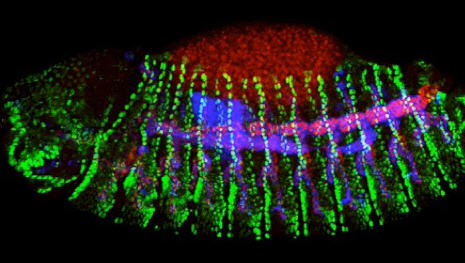A study using Drosophila flies reveals new regulatory mechanisms of cell migration

Tracheas of the fruit fly Drosophila melanogaster (in blue and red) are a good model to study cell migration (Author: E Butí, IRB)
A study by Sofia J. Araújo, a Ramón y Cajal researcher with the Morphogenesis in Drosophila lab at the Institute for Research in Biomedicine (IRB), elucidates the genetic regulation of cell migration.
Published today in the scientific journal Plos One, the research is part of the thesis work performed by Elisenda Butí, first author of the article.
Cell migration is highly coordinated and occurs in processes such as embryonic development, wound healing, the formation of new blood vessels, and tumour cell invasion. For the successful control of cell movement, this process has to be determined and maintained with great precision.
In this study, the scientists used tracheal cells of the fruit fly Drosophila melanogaster to unravel the signalling mechanism involved in the regulation of cell movements.
The research describes a new molecular component that controls the expression of a molecule named Fibroblast Growth Factor (FGF) in Drosophila embryos. The importance of FGF in cell migration was already known but little information was available on its genetic regulation.
In the study, Araújo and her team have discovered that a protein called Hedgehog, known to be involved in morphogenesis, regulates FGF expression.
“This is the first time that a direct connection has been demonstrated between the Hedgehog pathway and an increase in FGF during cell migration,” says Araújo.
“The results are really interesting for biomedicine,” explains the researcher, “as the Hedgehog pathway is overexpressed in some of the most invasive tumours, such as the most common kind of skin cancer.”
The team explains that this is a step forward for research into cell migration mechanisms and that future applications will emerge as further investigation and studies are conducted.
Reference article:
Hedgehog is a positive regulator of FGF signalling during embryonic cell migration
Elisenda Butí, Duarte Mesquita and Sofia J. Araújo
Plos One (2014) 10.1371/journal.pone.0092682
Media Contact
All latest news from the category: Life Sciences and Chemistry
Articles and reports from the Life Sciences and chemistry area deal with applied and basic research into modern biology, chemistry and human medicine.
Valuable information can be found on a range of life sciences fields including bacteriology, biochemistry, bionics, bioinformatics, biophysics, biotechnology, genetics, geobotany, human biology, marine biology, microbiology, molecular biology, cellular biology, zoology, bioinorganic chemistry, microchemistry and environmental chemistry.
Newest articles

A universal framework for spatial biology
SpatialData is a freely accessible tool to unify and integrate data from different omics technologies accounting for spatial information, which can provide holistic insights into health and disease. Biological processes…

How complex biological processes arise
A $20 million grant from the U.S. National Science Foundation (NSF) will support the establishment and operation of the National Synthesis Center for Emergence in the Molecular and Cellular Sciences (NCEMS) at…

Airborne single-photon lidar system achieves high-resolution 3D imaging
Compact, low-power system opens doors for photon-efficient drone and satellite-based environmental monitoring and mapping. Researchers have developed a compact and lightweight single-photon airborne lidar system that can acquire high-resolution 3D…





















